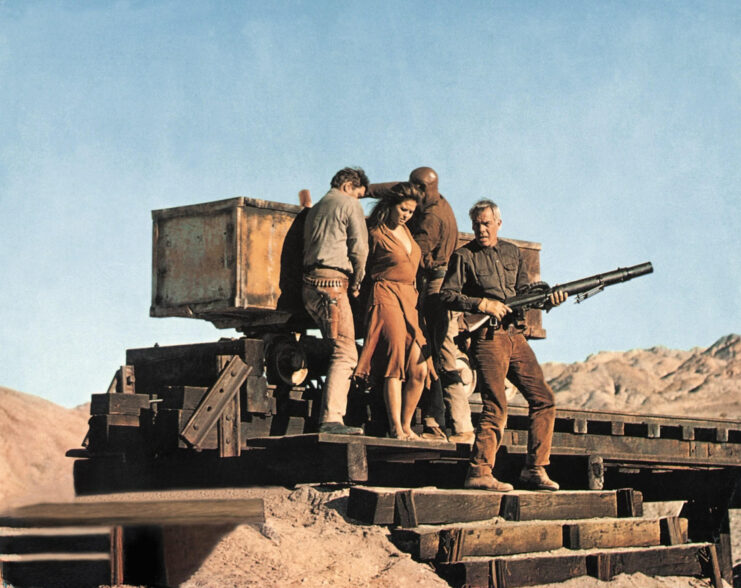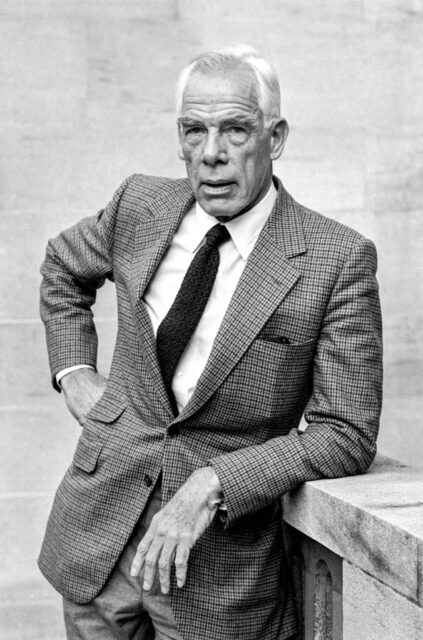Lee Marvin was a mainstay of cinema and television throughout the 1950s and ’60s. Known for his portrayal of villains and tough guys, he was a recognizable figure in everything he appeared in. What many might not realize is that he served in the US Marine Corps prior to embarking on his Hollywood career. In fact, he participated in numerous assaults in the Pacific Theater.
Lee Marvin was a troublemaker growing up

Lee Marvin was born Lamont Waltman Marvin Jr. on February 19, 1924 in New York City, New York. He was named after his first cousin, four times removed, American Civil War Confederate Gen. Robert E. Lee, and his father was a veteran of the US Army Corps of Engineers who’d served during the First World War.
Growing up, Marvin struggled with ADHD and dyslexia, with the disorders causing him to act up. He was a very poor student and didn’t care for education, resulting in him jumping between schools for most of his childhood. Marvin was expelled from many of them for misbehaving, with him regularly caught smoking cigarettes. He also once threw a classmate from the second floor of his boarding school.
Marvin eventually found himself at St. Leo’s College Preparatory School in Florida, but he eventually dropped out. He preferred to spend his time outdoors, with him once recounting that he spent much of his teenage years “hunting deer, puma, wild turkey, and bobwhite in the wilds of the then-uncharted Everglades.”
Serving in the Pacific Theater during World War II

Upon the US entry into the Second World War, Lee Marvin knew he needed to serve. However, he realized he wouldn’t be able to do so unless he graduated, so he returned to St. Leo’s College Preparatory School. On August 12, 1942, against his father’s wishes, he enlisted in the US Marine Corps. While he started out as a quartermaster, he became a sniper scout after finishing the School of Infantry.
Marvin was assigned to I Company, 3rd Battalion, 24th Marine Regiment, 4th Marine Division and sent to the Pacific Theater. He participated in 21 assaults on Japanese-held islands, among them Eniwetok and Saipan-Tinian. While participating in the attack on Mount Tapochau during the Battle of Saipan on June 18, 1944, his sciatic nerve was severed by machine gun fire. He received an additional shot to the foot from an enemy sniper.
The future actor wasn’t the only member of his company to become wounded during the engagement, with the Americans listing several casualties. Marvin spent the next 13 months receiving treatment in naval hospitals and was medically discharged with the rank of private first class. He’d originally been a corporal, but had been demoted for causing trouble.
Throughout the course of his service with the Marine Corps, Marvin received several decorations, including the Purple Heart, the Asiatic-Pacific Campaign Medal, a Combat Action Ribbon, the American Campaign Medal, the Navy Commendation Medal with V Device, the World War II Victory Medal and a Presidential Unit Citation.
Lee Marvin caught the acting bug

Following World War II, Lee Marvin found work as a plumber’s assistant at a local community theatre in upstate New York. Little did he know that this menial labor job would kickstart a decades-long acting career. He was asked to fill in for an ill actor and fell in love with the craft, eventually joining the company on a salary of $7 a week.
This led him to use his benefits under the GI Bill to attend the American Theatre Wing. Throughout his studies, he appeared in local theater shows, which ultimately allowed him to earn small parts in a variety of television productions and even a stint on Broadway in the 1951 production of Uniform of Flesh.
That same year, he scored his first film role as a signalman in You’re in the Navy Now, alongside budding actors Charles Bronson and Jack Warden. This led to a small part in Teresa (1951), which saw him permanently relocate to California.
Becoming a mainstay of the Western genre

The move to California proved to be fruitful, as it allowed Lee Marvin to become involved a several big-budget productions, albeit after he made his name on TV. He had guest appearances on the likes of Rebound (1952-53) and Fireside Theatre (1949-58) and scored small roles in such movies as The Duel at Silver Creek and Hangman’s Knot, both of which were released in 1952.
After his appearance in Seminole (1953), Marvin became an in-demand actor in the Western genre, following up the movie with The Stranger Who Wore a Gun (1953), Gun Fury (1953) and The Raid (1954). During this time, he earned critical acclaim with his appearances in The Big Heart (1953) and The Wild One (1953), the latter of which also starred Marlon Brando.
Not one to step away from TV, Marvin continued to guest star in several anthology productions and scored the lead role as Det. Lt. Frank Ballinger in M Squad (1957-60). This was followed by appearances in The Twilight Zone, (1959-64), Bonanza (1959-73) and Route 66 (60-64). In 1965, Marvin co-starred alongside Jane Fonda in Cat Ballou, a film that won him the Academy Award for Best Actor.
While he appeared in several big-budget movies, there were a number he turned down, among them Dirty Harry (1971), Death Wish (1974), For a Few More Dollars (1965), First Blood (1982) and The War of the Worlds (1953). He was even the first choice for the role of Quint in Jaws (1975), directed by Steven Spielberg, but declined. The part was ultimately given to Robert Shaw.
Lee Marvin starred in several war and military films

While he was best known for his Western roles, Lee Marvin appeared in several military and war films. His prior military service came in handy on-set, with him able to assist with costume design, the portrayal of infantry movements and the use of firearms.
As aforementioned, his first was You’re in the Navy Now, and he followed the movie up with Eight Iron Men (1952) and The Glory Brigade (1953). He then portrayed Meatball in The Caine Mutiny (1954) and Lt. Col. Clyde Bartlett in Attack (1954), and also starred in the direct-to-TV film Sergeant Ryker, which was released in theaters a few years later, after his star had grown.
Among the biggest war movies to feature Marvin was The Dirty Dozen (1967), starring an ensemble cast that included Charles Bronson, Jim Brown, Ernest Borgnine, Donald Sutherland and Clint Walker. While he was able to use his time in the Marine Corps to shape the character of Maj. John Reisman, he wound up disliking the film overall, saying it was nothing like real war.
As the years went on, Marvin continued to take roles in war and military genres, including Hell in the Pacific (1968), Shout at the Devil (1976), Avalanche Express (1979) and The Big Red One (1980). He also starred in the TV sequel to The Dirty Dozen, titled The Dirty Dozen: Next Mission, and co-starred alongside Chuck Norris in The Delta Force (1986).
Similar to other aspects of his film career, he turned down several roles in these lucrative genres, including Where Eagles Dare (1968) and the role of Gen. George Patton in Patton (1970). He reportedly declined the former because he didn’t want to star in another war movie.
Bad habits ultimately led to Lee Marvin’s death

Lee Marvin was known to be a heavy smoker and drinker throughout his life, habits that ultimately impacted both his personal and professional lives. He was known to smoke up to six packs of cigarettes a day and was often drunk, with it reported that he was frequently caught drunk driving, but that he got away with it by signing autographs for the officers who pulled him over.
One particular example of his alcoholism comes from the set of The Dirty Dozen, when he needed to be dragged out of a pub and brought back to the set to film a scene with Charles Bronson. Marvin’s co-star was so upset with him that he threatened him. It’s also reported that his drunkenness hindered production on numerous occasions.
In 1986, Marvin was hospitalized for two weeks due to complications from Valley Fever. He suffered from respiratory distress and had to be administered steroids, and wound up having intestinal ruptures that forced him to undergo a colectomy.
More from us: The Movies That Made Kirk Douglas One of the War Genre’s Best
A year later, the actor was hospitalized for two weeks with a “run-down condition related to the flu.” During his stay, he suffered a heart attack, which resulted in his death on August 29, 1987, at the age of 63. He was buried with full military honors at Arlington National Cemetery, and is interred next to professional boxer Joe Louis.
